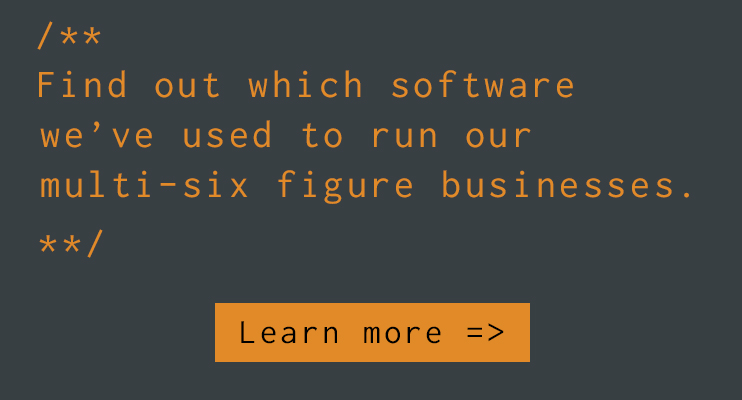For two and a half years, every two weeks I sifted through over 140 blog posts and podcasts that talk about how to build successful online businesses. I found the best content, summarized it, added a bit of my commentary, and delivered it to the inboxes of entrepreneurs around the world…for free. I’m no longer writing Signals in the Noise issues (because my business partners and I are focusing on other parts of Clarity Lab), but please enjoy these archived issues. There’s a ton of useful information in them!

Money-side up.
Every year at this time, my wife, Bari, and I open the doors to her year-long program, The Art of Money. At the same time the doors open for registration, we let out a flock of free, useful, and hopefully inspiring pieces of content. This year, it’s a series of intimate, behind-the-scenes conversations about money between Bari and several of her colleagues and past students. We call them Money Memoirs. It’s a new series of podcast episodes, full of the kind of open discussions about money you rarely, if ever, hear about money.
Why am I mentioning it here? One, The Art of Money is a business I’ve helped my wife build and run for many, many years (she started it 15 years ago.) Two, I’m profoundly proud of the program and path to financial wellness that my wife teaches, and the way she holds the community of hundreds of people that show up every year from around the world. Three, your relationship with money is one of the most important aspects of you building and running a successful business. Everything I share in this newsletter is designed to help you achieve that end. Which makes The Art of Money? Remarkably relevant.
Category: financial therapy.
I’m drawing a thank.
Want to know a simple way to make a surprisingly powerful impact in the lives of your customers? Send them hand-written thank you cards via old-school paper mail. (As in, the post office. Remember that place you used to go to 25 years ago before the internet happened?) Here’s the good folks at my favorite customer support software company, Help Scout, with a sharp post on how to crank your thank you card game to 100. I wrote them a thank you note for that post on my 1962 Hermes Rocket manual typewriter and am delivering it on the leg of one of the local ravens that lives near my house. It might take awhile to get there, but my words just seem to have more of an impact when they arrive on a raven flying into someone’s office.
Category: customer support
The Revenge of Analog
A big part of why thank you cards (and t-shirts with your company’s logo on them) make such a big impact on your customers is because a large percentage of your businesses presence in the world is likely online, in a purely digital space. You can’t hold a website in your hands. You can’t smell the ink on the pages inside an online program (because there isn’t any ink to smell.) But a handwritten thank you card? Or a t-shirt? Or a coffee mug? Your customers can hold all of them in their hands, in real life (or IRL for those of you who speak texting acronyms.)
Thank you cards are a perfectly personal example of the power of analog experiences in a world that’s being eaten by software and all things digital. In the best book I’ve read over the last five years, David Sax takes us on a tour through the resurgent uprising of analog technologies in The Revenge of Analog.
Vinyl records coming back from the dead. Board game cafes where people gather, play, laugh, and connect with each other without digital devices. An analog watch company in Detroit breathing life back into a city that lost its core manufacturing industry. Summer camps where phones and laptops are banned so that kids can be…just kids having timeless summer camp adventures in the woods.
The relevance of this book to anyone building a business that will have a majority of its interaction with customers in an online space cannot be understated. Order a physical copy of the book, or, better still, go to your local bookstore and buy a copy there. You will not regret it.
Category: trends.
I’ll have a large dataset on Medium, please.
“I pulled down the top 252 stories of 2016 — all of which had at least 2,500 recommendations from Medium’s readers — and analyzed the dataset. To put things in perspective, writers published 7,500,000 stories on Medium last year. So this dataset represents the most popular 0.00336% stories of 2016. Together, these 252 stories racked up 1,033,961 recommendations. That’s a lot of green hearts.” Quincy Larson, from Free Code Camp, gives us an analysis of the data from the top Medium posts from 2016. (If you don’t know what Medium is, it’s a bit like Facebook/Twitter for writers who like to post long form content.)
The insights he gleaned from the data are quick and useful, like this one: “You don’t have to be famous to do well on Medium.” That’s good, because I’m only famous to my cats. They know me as “Tall human who gives us food and petting.”
Category: blogging
I’m not dead yet!
Speaking of Medium, hold onto your seats. Everyone’s favorite new blog publishing platform just experienced a bit of an earthquake. I don’t think they’re going anywhere soon, but the news is a bit unsettling, if you love the platform as much as I do. The Verge’s Casey Newton: “Publishing platform Medium announced today that it had laid off 50 people — about a third of its staff — amid growing concerns about its advertising-based model. The company said it would explore alternatives to pageview-based advertising in the hopes that it can develop a lucrative, sustainable alternative for writers publishers.” This news is good to be aware of, so you can watch what happens with Medium as a company. Many content marketers, like me, are starting to publish content on Medium, so any hint of the company folding can be a bit unnerving. (I just got my pom-poms out of the closet, and I’m cheering for Medium. Don’t ask why I have pom poms.)
Category: tech company news
Break it down for me fellas.
I always find it incredibly interesting to see a breakdown of where a given online entrepreneur is making their revenue from, particularly when they’re selling information products, like online courses. I just came across this great breakdown from Darren Rowse, the founder of ProBlogger (one of the oldest blogs on the web.) That post shows a percentage breakdowns of where his income came from in the first half of 2016. Every time I try to make a pie chart like that I end up going out to buy a blueberry pie. I like eating physical representations of data.
Category: revenue streams.
Spendmail.
What do you get when a company snoops around and finds out what online marketers are searching for on the web? A telling graphic that shows the coming trend for 2017: email and video based marketing will get the most money and attention within many companies. That may not be surprising if you follow trends in the marketing space, but what may surprise you is something that’s notably missing from this chart of the top ten most searched for topics in the marketing space: social media marketing. That didn’t even make the top ten.
To me, that just confirms what we saw happen in 2016 with regard to the massive decrease in social media marketing efforts by companies large and small. The ROI just isn’t there for most businesses with social media marketing. What’s there is cat videos.
Category: marketing.
A shot in the spark.
Here’s the best new tech tool find of the week: Adobe Spark. It’s a social media graphic, animated video, and web photo storytelling tool. It’s worth checking out.
Category: tech tools.
Homebrand security.
“I started to pay attention to the murmurings about personal branding, and I realized how genius it is. Entrepreneurs put so much of ourselves into our businesses already that it makes perfect sense to make yourself the foundation of that business. It makes every decision so much easier because you’re not constantly trying to gauge the whims of the market. You’re just asking what you want to do and what best serves your audience. Being a “Youpreneur” is very intuitive that way.” Chris Ducker, on the power of building a personal brand business, like the one we’ve built for my wife, and how it can end the cycle of stress and competition in your business life. Alright, that’s it. I’m starting my own personal brand business. I think I’ll call it “The National Forest Service.”
Category: branding.
Passive obsessive.
“So it’s not about how little you work or finding ways to not work at all. Passive income is about leveraging your time to have greater impact and grow your business. It’s about investing a lot of time in your business at the beginning to create products that people can’t ignore and processes to keep your customers feeling cared for so that you can benefit from it all later. It’s all about learning how to scale your business so that as you make more sales you don’t create more work on your end.” That’s Dani Stewart, on the ConvertKit Blog, with a sharp article that pulls back the curtain on passive income. What it is, how to create it, and how much work it actually takes.
I’ve built several businesses with products that would fall into the category of being “passive income” products, and I’ve never worked as hard in my life to create those products. There’s nothing passive about them. It’s closer to the truth to call this kind of income “time-delayed active income,” where you work your ass off for a long time and because your products are online, and customers around the world can buy them, sometimes money comes in while you’re sleeping, or on the beach, or, sleeping on the beach, which makes it a worthy pursuit.
As always, thank you for spending a few minutes with me today in this issue of Signals in the Noise.
If you enjoyed it, I’d love it if you share it with your friends. Here are a couple of links to make that easy:
And remember, you can always print this issue out on paper and hand deliver it to a special someone who might get something useful out of it. Your act of kindness will mean even more if you wear a raven costume when you deliver it to them.
Alright. The clock is ticking. Our time here on this planet is running out, simply because our lives are brief. What do you want to do with the rest of your time? How will you make the world a better place? Is what you’re focusing on today going to help you get closer to reaching your bigger goals in life?
Things to ponder…
With great respect for you and what you’re working on,
~Forest Linden
Editor-in-chief for Signals in the Noise
Co-Founder @ Clarity Lab
p.s. You can find the archive of past issues right here.

